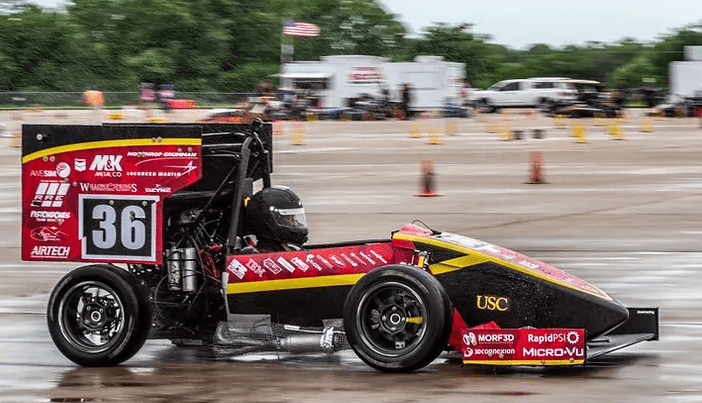TotalSim's Sponsorship & Tools take Collegiate FSAE Team to the Next Level
The Situation:
The University of Southern California’s Formula SAE Racing Team is an entirely student-run organization that designs, constructs, tests, and races high performance autocross race cars as part of SAE International’s Formula SAE program and competition. Like all collegiate FSAE teams, they compete against universities from across the globe in an ultimate test of their car’s abilities.
Client Challenge:
USC FSAE’s Aerodynamics subteam wanted to find a way to more efficiently utilize CFD technology to generate the aero data needed to design and optimize their car. Not being CFD experts and relying on school and team resources, they had been conducting simulations through CFD software run locally on personal computers with in house meshes and physics conditions. Extensive time was required to set up these meshes for each new part design and ensure the solution reasonably converged.
Type of TotalSim Engagement:
TotalSim offers collegiate FSAE teams sponsorship and free access to our TS Auto app, along with engineering support. USC FSAE took advantage of this sponsorship, and used TS Auto to streamline their CFD process.
What TotalSim did:
Just like commercial businesses, FSAE teams can use CFD to develop and optimize their vehicles by leveraging accurate aerodynamic data and running simulations. Without a tool like TS Auto, these academic teams are tasked with undertaking a complex CFD process using personal computers, painstakingly creating their own meshes without the benefit of automation and spending an inordinate amount of time learning the CFD process through trial and error. And, being comprised of students, the teams also have to contend with knowledge gaps that can occur when key team members graduate, taking that hard-won CFD know-how with them.
The TS Auto app allows FSAE teams to automate the entire CFD process so that users can receive valuable aerodynamic data on their vehicle without having to learn the complex CFD setup or spend time building meshes. The user simply uploads their geometry and inputs basic run conditions, and the app delivers a solution within 12-24 hours.
The USC FSAE Racing Team used TS Auto to design and develop their air ducts, rear wing, rear wing mounts and undertray, as well as running an aero map.
Results:
With the ease of use and fast turnaround provided by the TS Auto app, the team was able to focus more on understanding the entire vehicle's aerodynamics and vehicle dynamic effects rather than spending significant amounts of time on CFD setup. The team was able to model more intricate geometries using TS Auto that were not otherwise possible with locally run CFD software. And they felt that the CFD results produced by TS Auto were far more accurate and representative of the real world. They found the automated post processing especially helpful as it allows quick comparisons between different geometries, leading to faster design times.
TS Auto helped the team design an undertray around the existing aerodynamics package to significantly improve downforce generation of the overall vehicle—increasing the vehicle's downforce coefficient from 1.9 to 2.5 while minimally increasing drag coefficient from 1.18 to 1.23. The team also used TS Auto to redesign the vehicle's cooling duct for maximum efficiency due to a shrinkage in the radiator.

Learn more about the ways TotalSim can help you overcome your aerodynamic challenges
*What is CFD?
Computational fluid dynamics (CFD) is a branch of fluid mechanics that uses computer numerical analysis and data structures to analyze and solve problems that involve fluid flows, typically solved on large supercomputers. Fluid mechanics plays a significant role in the engineering process when developing new designs. Analyzing the aerodynamic and thermal qualities of a product using experimentation is a well-established approach however experimentation can be costly, limiting, time-consuming, and difficult to execute especially on a large scale. Progression of computing power has allowed the field of CFD to prosper acting as a complement to physical testing and in some cases replacing it. CFD is the science of predicting fluid flow, heat transfer, mass transfer, chemical reactions, and other flow properties by solving governing fluid flow equations using numerical methods. Across the industry, CFD is routinely used to drive product development, troubleshoot issues, study and optimize new designs and concepts, and map performance. CFD methods are heavily used across many disciplines with motorsports being a leading proponent.
